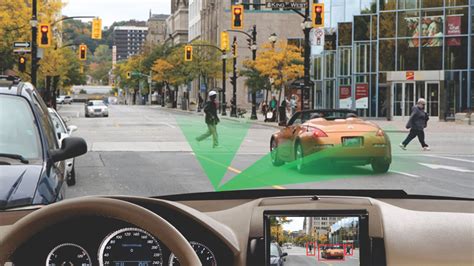These days, cars are used for much more than just getting around. They are now highly developed devices designed to make life less stressful, safer, and more enjoyable. Advanced Driver Assistance Systems (ADAS) are an innovative technology that increases the standard for automotive safety and convenience. Imagine ADAS in cars as a very capable co-pilot who is never bored or distracted. It is not a substitute for the driver. It’s helpful. It observes the road, analyzes information, and responds more quickly than humans. The aim? Reduced accidents, safer roads, improved driving. ADAS isn’t just one function. It is a network. a radar, sensor, camera, and AI system. All of these provide information to the car’s brain, enabling it to make judgments instantly.
ADAS and how it works
A vital technology that improves road safety is Advanced Driver Assistance Systems (ADAS). They include cameras within the vehicle that track the driver’s head position and eye movements, as well as specialized cameras like thermal and stereo cameras used for particular tasks. There are three varieties of radar: short, medium, and long-range. Radar is essential for measuring distance and detecting relative velocity.

These technologies greatly improve road safety by enabling ADAS features like adaptive cruise control and collision avoidance. On the other hand, drivers may overestimate the capabilities of ADAS, which could result in riskier driving behavior and other adverse impacts, like risk adaptation and attention loss. Developing successful ADAS implementation plans and understanding the technology’s effects on road safety requires an understanding of both its advantages and disadvantages.
Different Types of ADAS Features
Lane Departure Warning Systems
Lane Departure Warning System gives you a heads-up when you’re veering off your lane, ensuring you stay on the straight and narrow. Some advanced systems can even nudge your vehicle back to the center of the lane. It’s like having a friendly co-driver who’s always got your back.
Blind Spot Detection
Blind Spot Detection (BSD) is a crucial feature that alerts drivers of potential vehicles sneaking into their blind spots, preventing heart-stopping side-swiping moments and keeping them alert to potential dangers that mirrors cannot see.
Adaptive Cruise Control
Adaptive Cruise Control (ACC) is a crucial feature in ADAS that allows drivers to maintain a safe distance from the vehicle ahead while driving, providing a break from pedaling. Modern ACCs can even bring the vehicle to a complete stop and resume driving without driver input.
Forward Collision Warning and Automatic Emergency Braking
The Forward Collision Warning (FCW) system is a safety feature that alerts drivers to excessive speeding on the vehicle in front, and with Automatic Emergency Braking (AEB), the car can automatically apply brakes if the driver fails to respond, providing a sense of personal bodyguard.
Park Assistance
Park Assistance systems make parking in tight city spaces easier by guiding users to parallel or perpendicular parking spaces, and some even offer remote parking, allowing cars to park themselves while outside. This is a step towards the future of parking.
Traffic Jam Assist
Traffic Jam Assist is a feature that helps drivers navigate traffic jams by maintaining a safe distance from the car in front and providing steering assistance, providing a mini-vacation for driving senses during bumper-to-bumper situations.
Night Vision Systems
Night Vision Systems utilize infrared sensors or thermal imaging to detect objects beyond your headlight’s reach, ensuring safety for those venturing out after dark, including pedestrians and animals.
Key Features of ADAS

Collision avoidance: Prevents rear-end collisions by applying brakes or alerting the driver.
Pedestrian detection: Recognises pedestrians crossing the street and takes appropriate action to prevent collisions.
High beam assist: Because nobody enjoys being blinded while driving, this feature automatically lowers your high beams when there is oncoming traffic.
Driver monitoring systems: This keeps an eye out for indications of weariness or inattention and suggests that you take a break.
Key benefits of ADAS
Advanced Driver Assistance Systems (ADAS) enhance road safety by facilitating collision avoidance through features like forward collision warning (FCW) and automatic emergency braking (AEB). These systems use sensors to detect potential collisions and alert drivers or apply brakes autonomously. Lane departure warning systems reduce the risk of accidents due to unintended lane departures. ADAS also offers adaptive cruise control, which maintains a safe following distance and manages traffic flow, thereby improving overall driving safety. These features play a crucial role in mitigating accidents and improving road safety.
Challenges
The implementation of Advanced Driver Assistance Systems (ADAS) faces several challenges, including technological constraints, interoperability issues, and human factors. Technological constraints involve the limitations of current ADAS features and the need for further advancements. Interoperability issues involve seamless integration of ADAS components within vehicles and across different models. Human factors, such as driver awareness and trust, also pose significant challenges. Ethical dilemmas and a lack of formal driver education on ADAS usage can compromise road safety. Therefore, it is crucial to critically assess the implications of ADAS and address the challenges to ensure their positive impact on road safety.
How ADAS works in chaotic city traffic
City roads are truly unique. And driving in the city is an experience in itself because of the unpredictable drivers, traffic hawkers, careless pedestrians, as well as careless drivers. What role does ADAS technology play in this context, then? While a feature like the lane-keeping assist will work well on highways, the adaptive cruise control will work well on the lower sections of the highway. The blind-spot detection feature will also be beneficial in populated cities where the roads are full of cars every now and then.
Future innovations in ADAS
Advanced Driver Assistance Systems (ADAS) hold significant potential for advancements in sensor technology, integration with autonomous driving systems, and regulatory changes. The automotive industry is focusing on higher-level automation features to shape ADAS’ trajectory and impact on road safety. ADAS currently reaches level 2 in the Society of Automotive Engineers (SAE) classification, encompassing environment perception, behavior planning, and motion control. Future trends and innovations are crucial for enhancing vehicle safety and reducing human errors, as ADAS plays a pivotal role in avoiding traffic accidents and improving transportation safety.




